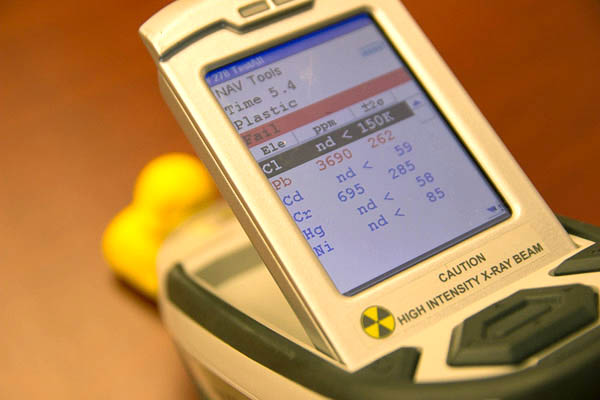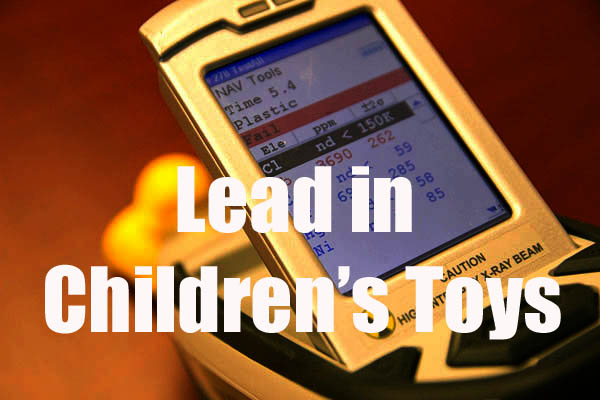 While you are probably aware of the dangers of lead paint in older homes and buildings, did you know that high concentrations of lead may also be lurking in your children’s toys? Many people have no idea. It just so happens that I have a vested interest in this matter. My daughter is a lively 18-month old, she just loves playing with her toys and also likes to see how they taste. I am a full-time Environmental Consultant with a strong background in lead. I am also an EPA Lead Risk Assessor, as well as an EPA Principal Instructor for lead programs. So how do you think I felt when I discovered that some of my daughters own toys were riddled with lead? Well, that’s why I am writing this post, to raise awareness of this well-kept secret!
While you are probably aware of the dangers of lead paint in older homes and buildings, did you know that high concentrations of lead may also be lurking in your children’s toys? Many people have no idea. It just so happens that I have a vested interest in this matter. My daughter is a lively 18-month old, she just loves playing with her toys and also likes to see how they taste. I am a full-time Environmental Consultant with a strong background in lead. I am also an EPA Lead Risk Assessor, as well as an EPA Principal Instructor for lead programs. So how do you think I felt when I discovered that some of my daughters own toys were riddled with lead? Well, that’s why I am writing this post, to raise awareness of this well-kept secret!
“In 2006 a 4-year old boy from Minneapolis died . . .”
The Problem with Lead
 Lead is an abundant and naturally occurring heavy metal. However, it is also a neurotoxin. Exposure to lead can result in blood poisoning, causing significant health effects such as nerve damage, stunted growth, seizures, kidney damage, and learning/behavioral problems. While lead can be breathed in, the main route of exposure for children is by swallowing. This is why children’s toys potentially having lead is a major concern. Just think about how many times your children have put toys in their mouths!
Lead is an abundant and naturally occurring heavy metal. However, it is also a neurotoxin. Exposure to lead can result in blood poisoning, causing significant health effects such as nerve damage, stunted growth, seizures, kidney damage, and learning/behavioral problems. While lead can be breathed in, the main route of exposure for children is by swallowing. This is why children’s toys potentially having lead is a major concern. Just think about how many times your children have put toys in their mouths!
In 2006 a 4-year old boy from Minneapolis died after swallowing a heart-shaped trinket that contained over 90% lead. According to a study performed by Cornell University, approximately one in fifty young children in the U.S. have a lead blood level above the Federal standard. Most healthcare professionals agree that there is no safe level of lead exposure.
Lead in Toys?
 When we first mention the possibility of lead in toys, most people think of painted toy soldiers from many years ago. While these types of toys often contain lead paint, you may be surprised to know that brand-new plastic toys are commonly identified to contain dangerous levels of lead. In fact lead has commonly been used as a stabilizer in PVC products and for pigmentation in paint, rubber and plastics. So what does this mean? To start, it makes the simple identification of these products very difficult. It’s simply not just old painted toys we are concerned with, but modern plastic and PVC ones too!
When we first mention the possibility of lead in toys, most people think of painted toy soldiers from many years ago. While these types of toys often contain lead paint, you may be surprised to know that brand-new plastic toys are commonly identified to contain dangerous levels of lead. In fact lead has commonly been used as a stabilizer in PVC products and for pigmentation in paint, rubber and plastics. So what does this mean? To start, it makes the simple identification of these products very difficult. It’s simply not just old painted toys we are concerned with, but modern plastic and PVC ones too!
Aren’t there Laws?
The Consumer Products Safety Commission (CPSC) regulates the allowable limit of lead in children’s products. The current limit stands at 100 parts per million (ppm). While the CPSC mandates that products imported into the U.S. be tested for lead, many items such as plastic toys and costume jewelry still make it through our ports and onto our shelves. For example, in a 14-month period from 2006 to 2007, over 4-million voluntary recalls were made due to excessive lead in toys. The overwhelming majority of these toys were made in China.
At Karl Environmental Group, we have been using an XRF analyzer made by Thermo-Fisher Scientific to detect levels of lead in consumer products. Our tests have identified that some children’s toys contained up to 53 times the legally allowable amount of lead, and these weren’t just older toys but brand-new ones too. Many of the toys we tested were the perfect size for young children to bite and teeth on, therefore potentially exposing them to high concentrations of lead.
“. . . some children’s toys contained up to 53 times the legally allowable amount of lead . . .”
How Should I Protect My Children?
Considering the serious and long-term health implications of lead blood poisoning, this is not something that should be taken lightly. Here are some simple steps you can follow to help reduce your children from being exposed:
- Stick with brand-name toys: While there have been several recalls for toys from national manufacturers in the past, these companies are now more aware of the potential implications, meaning they are more likely to test new products and imports.
- Subscribe to recall notices: Sign-up for product recall notifications from the CPSC website so that you can stay on top of any recalls.
- Throw out Grandma’s Toys: Our testing identified that older toys (even those from as recent as the 1980s) were far more likely to contain lead and lead paint. If you don’t want to throw out these toys you may want to consider having them tested or just hold onto them until your children are older and can handle them properly.
- Buy toys manufactured in the USA and European Union: Toys produced in the U.S. and E.U. are subject to stricter regulations than their counterparts made in China and Pacific Rim countries.
- Opt for wooden toys over plastic: Quality wooden toys are often manufactured to a higher specification and won’t contain the stabilizers used in PVC products. Besides, these toys often look much nicer and last longer.
- Don’t give metal jewelry to children: Jewelry products are not subject to the same regulations as toys and often contain very high levels of lead and other dangerous heavy metals.
- Have your children tested for lead: A blood screening should be performed by healthcare professionals at ages 1 and 2. Due to problems with lead paint in homes, many states now mandate regular testing.
- Have your toys and other items tested: The CPSC maintains a list of laboratories who are able to perform testing of consumer products.
If you believe your child may have been exposed to lead, speak to your health care provider about having their blood tested for lead. The links at the end of this page provide more information about this topic. Please share this post and help us raise awareness about this issue!
Darren Townsend
Environmental Consultant and Father

